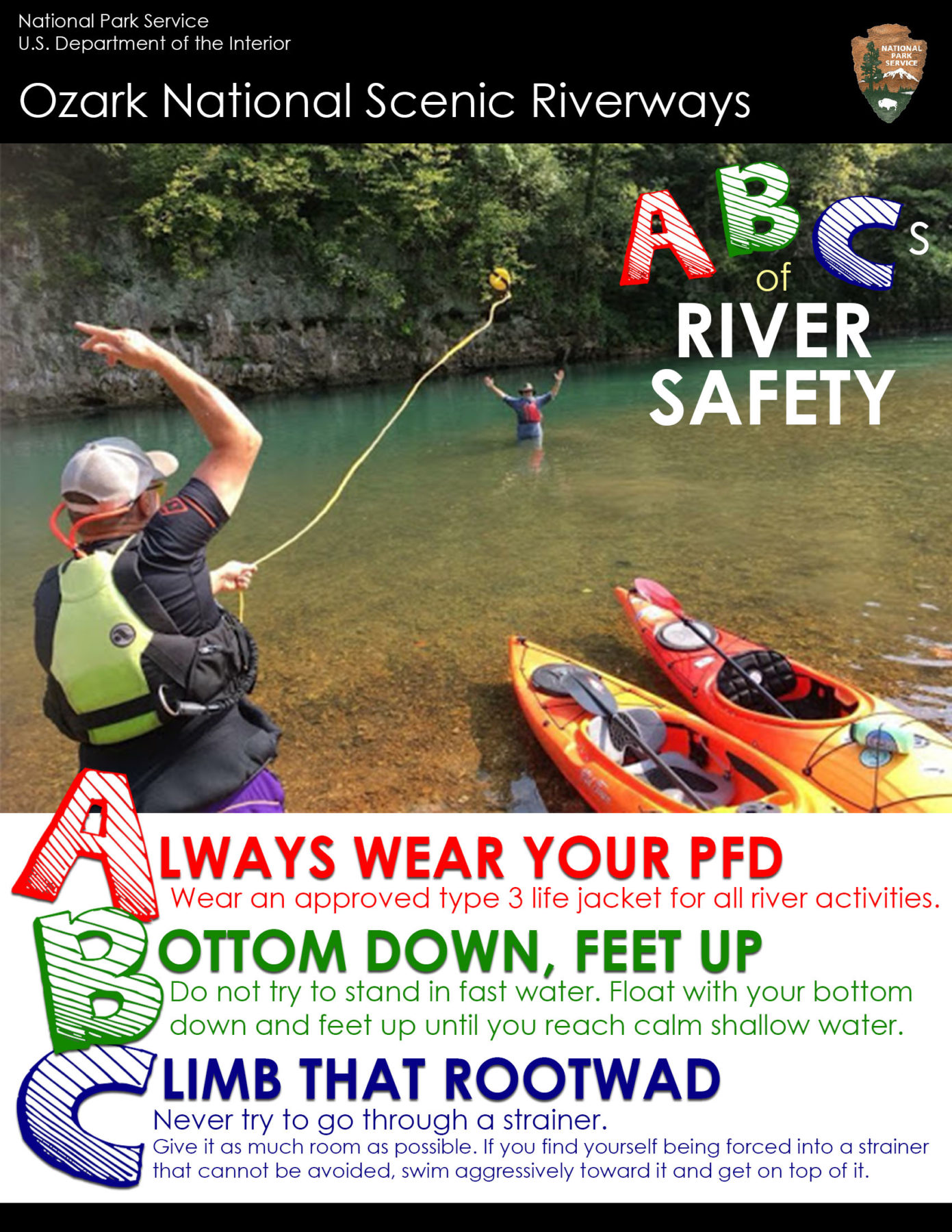A: Always wear a PFD. B: Bottom down, feet up. C: Climb that rootwad.
If the ABCs of river safety are all you have the opportunity to learn prior to heading out on some of Missouri’s famous waterways, you’ll at least have the bare-minimum basics. This simple code is used by interpretive rangers at the Ozark National Scenic Riverways (ONSR) as part of the park’s summer kayaking clinics.
Need a bit more explanation? Here you go.
Always wear a PFD. The best personal flotation device (PFD), aka life jacket, for paddling is the approved Type III. But it does no good if you’re not wearing it. Accidents happen in split seconds, and if you’re sitting on your PFD or using as a backrest, there’s not time to put it on when you need it. Be sure you have your PFD on and zipped up, with the straps pulled tight for a snug fit.
Dave Tobey, retired ranger for the Upper Current District of the ONSR, likes to stress that during his tenure there was never a drowning fatality on the Upper Current of a person wearing a PFD. So, increase your odds of a safe trip by the simple step of wearing your life jacket, not just throwing it in your boat.
Other useful tips include attaching a safety whistle near the shoulder of your PFD, within easy reach of your mouth. A small, clip-on, waterproof flashlight can also come in handy.
Bottom down, feet up. If your canoe or kayak flips and you go for an unintended swim, focus on taking care of yourself; let others in the group round up your boat and gear.
Ozark rivers are known to have rocky bottoms, submerged boulders, and plenty of fallen logs under the surface. The risk of foot entrapment is real and can be deadly if your body is pushed forward by the current and your head bobs up and down in and out of the water.

If you find yourself in the river, position yourself facing downstream (in the direction the water is flowing), with your bottom hanging down and your toes poking up above surface. If you’re wearing your PFD, this position is easy to hold. Steering with your arms, keep that position until your bottom hits the gravel, then you can safely stand up in calm, shallow water.
If someone in your paddling group tosses you a safety rope, place it over your downstream shoulder, with your back to the person, and let yourself be pulled to shore.
Climb that rootwad. If you’re like most people, the last place you want to be is on a rootwad. If you get swept into one, there’s a strong possibility that you’ll get pinned there and perhaps get filled or stuck underneath.
A rootwad, if you aren’t familiar with the term, is also referred to as a strainer. It’s the big ball of roots of a fallen tree, often right out in the middle of the stream or along the outer edge of a tight turn, making the risk of getting swept against it quite high.
Looking ahead and planning your approach can help you avoid rootwads. Learning basic safety skills and padding strokes can help, too. If you’re ever in doubt about your ability to navigate the route, do not hesitate to get out and pull your boat through the shallow water along the edge until you’re past the danger.
If you’re not been able to steer clear of the rootwad, then just as your boat hits it, step out and climb up quickly. Get your body out of the water as much as possible, then await rescue from others in your group or take the time to look around and plan your own escape route.
If you’d like to learn more about paddling safety and skills, visit the American Canoe Association (ACA) at americancanoe.org and search their educational videos for canoes, kayaks, stand-up paddleboards, and rafts.
A Few Extra Tips
Paddle in a group of three or more. That way, someone can stay with an injured or waylaid person while someone else goes for help.
File a float plan. Always let someone know where you’re going, when you expect to be home, and any stops (overnight or otherwise). This is especially important if you paddle solo.
Take a satellite communications device. Cell phone signals are often nonexistent in remote river areas.
Bring the essential gear. Make sure at least one person in your group packs a first-aid kit in their dry bag. Rain gear is also a must, as the weather can change in a flash.
Don’t forget water and food. Especially in Missouri’s summer heat, you’ll need more water than you anticipate, and energy-rich snacks can help you keep on paddling.
Paddle sober. One of the most important things you can do to have a safe river trip is to keep the alcohol for afterward.
Author: Barbara Gibbs Ostmann is a contributor to Terrain Magazine.


Leave A Comment